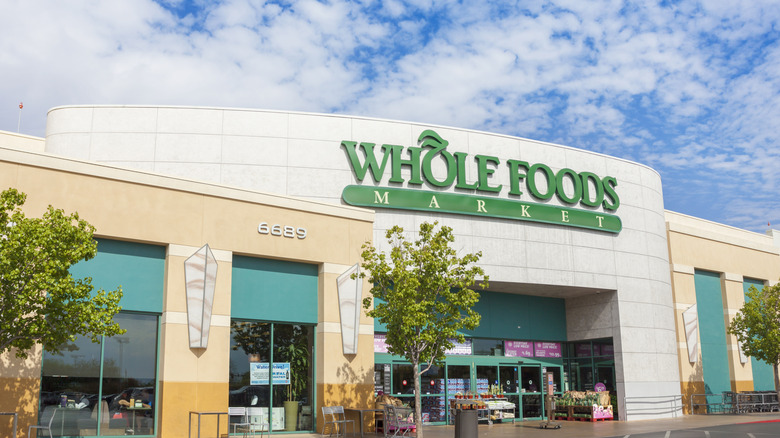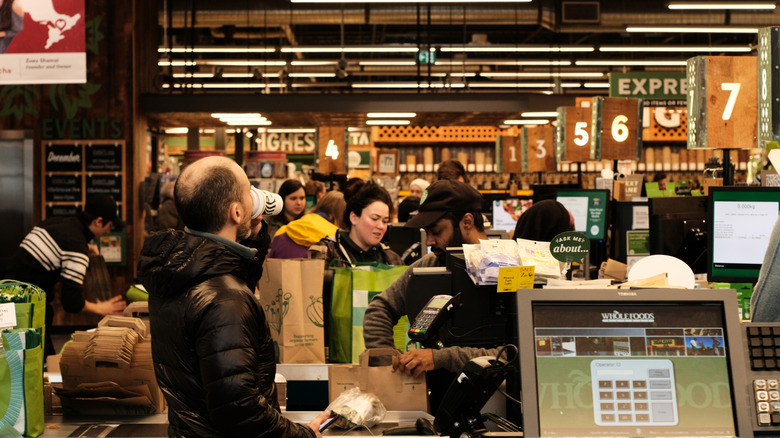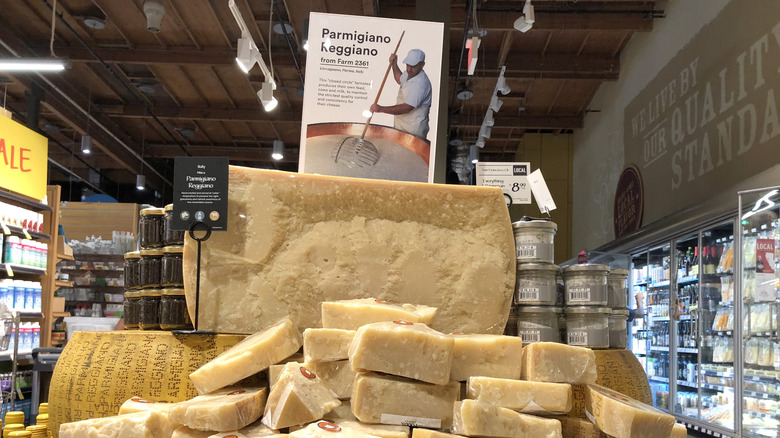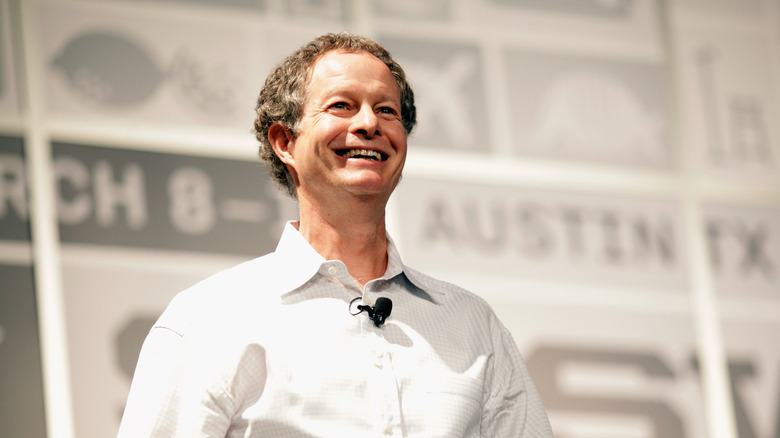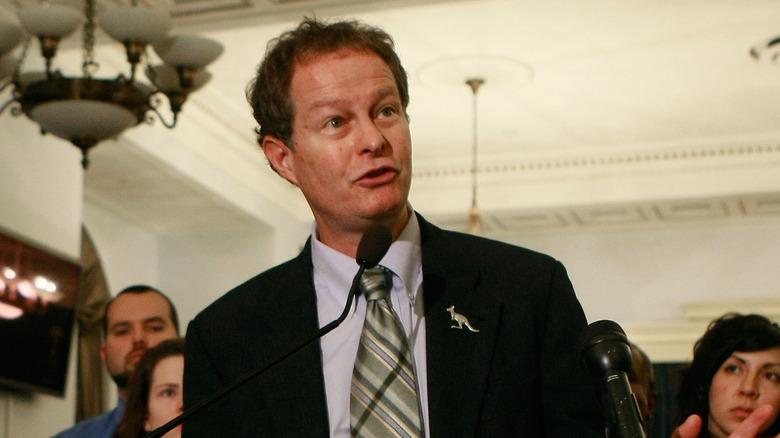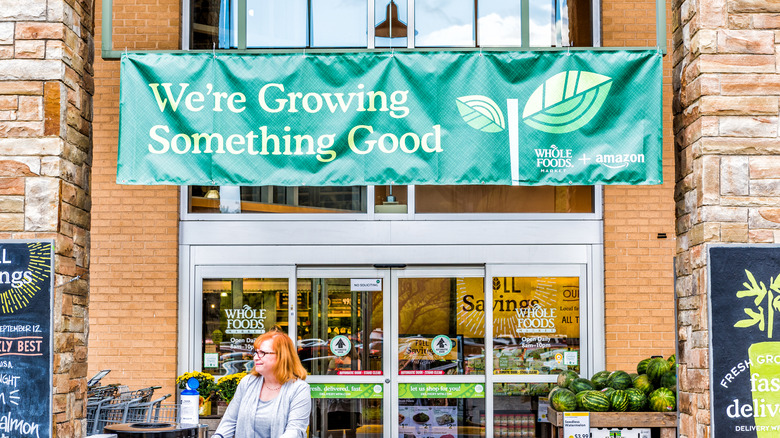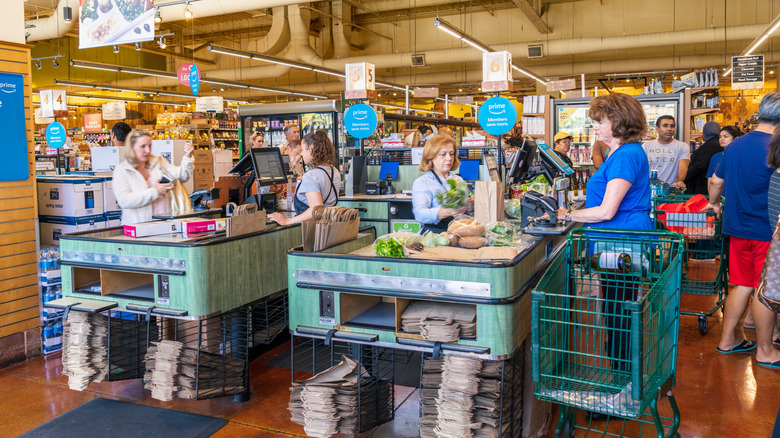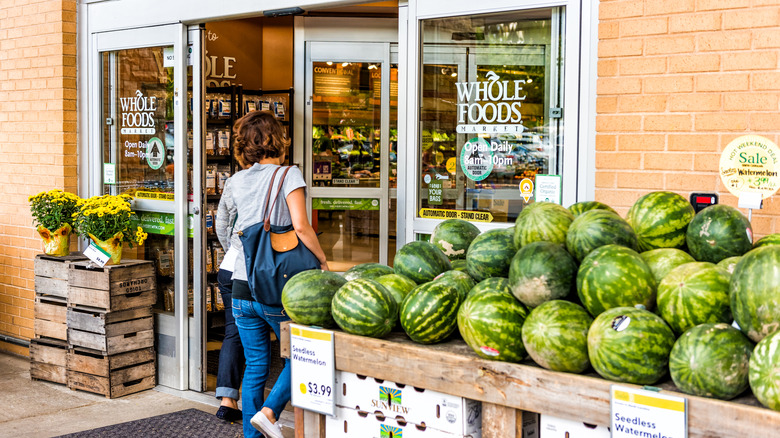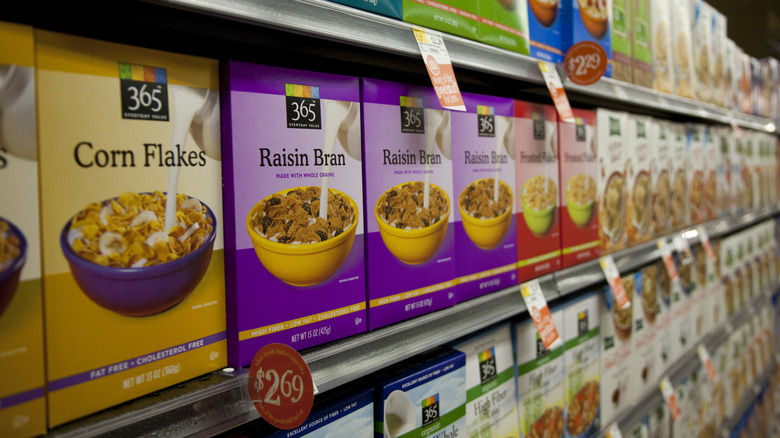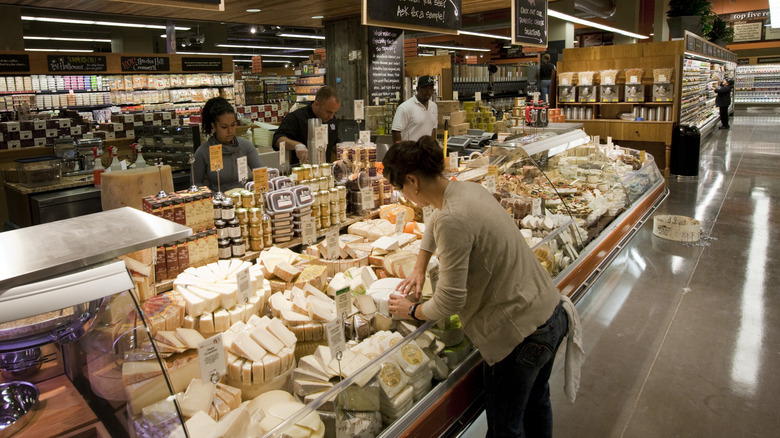Secrets Of Whole Foods You'll Wish You Knew Sooner
We may receive a commission on purchases made from links.
It may be unofficially known as "Whole Paycheck" for its high prices, but Whole Foods has some seriously high-quality items. There are plenty of secrets behind the healthy living-focused chain — some that you might expect and others that may just surprise you. The store has been around since the 1980s, staying true to its values of providing safe and delicious foods from the very beginning. You might be surprised to find that even the original store location in Austin has a story to tell.
The journey of its founding and founder is just as memorable as many of the delicious staples, tasty prepared foods, and special treats that you can find on the shelves. While Whole Foods has had its share of controversy over the years, many of the most fascinating facts date back to the early days or showcase how its mission remains the backbone of the company today. Once you know the secrets to this high-end grocery store, your wallet and your taste buds will be equally happy to give it a try.
It stopped using plastic bags in 2008
In recent years, stores and even states have enacted single-use plastic bag bans in an effort to reduce the waste generated when shopping. It's not surprising that Whole Foods, a grocery store known for its eco-friendly approach, nixed plastic bags early. They debuted this new policy in 2008, although some critics over the years found fault with the amount of plastic used to package food items. But the ban on plastic bags at checkout did help change the culture of grocery shopping and Whole Foods shoppers embraced the recycled paper bags that the store stocked instead.
Other measures taken by the chain include reducing the size of produce bags, which are still made of plastic, and no longer offering plastic straws. These policies came in 2019, quite a bit later than the initial push to get rid of plastics. Instead of plastic straws, most customers are given paper straws or encouraged to bring their own reusable straws or go straw-free. Other steps include getting rid of styrofoam in meat packaging and using bags instead of plastic clamshells for rotisserie chicken.
It held a Guinness World Record for cheese
In 2008, Whole Foods stores across the U.S. and Canada cracked wheels of Parmigiano Reggiano at the same time to set the record for the "most Parmigiano Reggiano wheels cracked simultaneously," according to the Redmond Reporter. The local store in Redmond, Washington was one of those that participated in the record-breaking feat. Whole Foods planned the coordinated cracking to bring attention to and celebrate the delicious cheese. Cracking requires careful attention and special tools to split the wheel smoothly to reveal the interior. Parmigiano Reggiano has a thick rind, which is a great way to impart flavor to broth and soup, even after you're done enjoying the hard cheese inside. At most stores, you can pick up a much smaller piece or have one cut to a specific size. While you're there, check out the displays with giant wheels of Parmigiano Reggiano to get an idea of just how notable the event was.
To set the 2008 Guinness World Record, 176 Whole Foods stores cracked almost 300 wheels at the same time. Now, the closest record is held by a Canadian company that set it in 2014 by cracking more than 1,000 wheels of Parmesan cheese. However, Parmesan and authentic Parmigiano Reggiano aren't the same thing so as far as we can tell, Whole Foods still reigns at the top for cracking this exact variety of cheese.
The original store ended up underwater
The very first Whole Foods store was in Austin, Texas and the chain still has strong ties to the city. The world headquarters office is located in Austin as well. But a 1981 flood in Austin brought water into the very first Whole Foods Market store, soaking inventory and causing damage. The water came from overflowing creeks, which rose due to high amounts of rainfall.
The flood occurred over Memorial Day in 1981, less than a year after the store had opened under the Whole Foods name. It was the most extensive flooding the city had seen in decades, and impacted homes and businesses all around the city, including Whole Foods. So when flooding destroyed around $400,000 of goods in the store, it might have been the end of the endeavor completely. It took 28 days for the store to recover, which was only done with the help of community members who wanted to see the store succeed. The store didn't have insurance, so it became a grassroots effort to take care of clean-up and repairs. Whole Foods managed to recover and was even able to expand just a few years later.
One store has an ice rink on the roof
The same location on North Lamar Street in Austin that suffered flooding in 1981 now embraces some extra H2O in the form of ice. The downtown Whole Foods Market store has an ice skating rink on the roof, where visitors can go whether they are shopping inside or not. While Texas isn't exactly known for its frigid weather, Whole Foods manages to keep the rink open for visitors, who can pay a small daily fee of $10 to get on the ice. It's open from 11:00 a.m. to 9:00 p.m. for skaters to enjoy. The ice rink is also available for party rentals, although you have to contact them directly to book ahead of time.
This attraction is one of numerous special spots at this flagship store. There is a pizzeria, Mexican food station, smoked meats spot, a burger grill, and a place to pick up homecooked-style meals. You can also pick up something to drink from the coffee bar, juice bar, or boozy bar. However, you won't necessarily be able to bring all of your selections, particularly those with alcohol, on the ice with you. You can always enjoy something to eat or drink at one of the in-store dining spots then head to the rink to lace up your skates.
CEO John Mackey makes $1 per year
Whole Foods began in 1978 as a labor of love for founder John Mackey when he was just 25 years old. Along with co-founder Renee Lawson, Mackey had to borrow money to open the first store, which they called SaferWay. It became Whole Foods in 1980 after merging with another health food store in the Austin area. At that time, Mackey probably couldn't imagine that one day the company would be sold for $13.7 billion, but that's exactly what was in store when Amazon purchased Whole Foods in 2017. Mackey himself was worth around $75 million at the time, according to Forbes, but his income doesn't come from his salary.
Whole Foods CEO and Founder John Mackey has a $1 annual salary. He's been at the helm of the chain of stores from the beginning as CEO or co-CEO, even after the sale to Amazon. But he's there to do his day job because he believes in the mission and vision of the store, not to collect a paycheck.
But don't worry, Mackey still gets to reap the benefits of his years of building Whole Foods into the brand that it is today. His financial compensation comes from the shares of Whole Foods that he owns. He also put limits on executive salaries tied to the wages of store workers. The cap on pay, even at the top, is 19 times the average wage of Whole Foods employees across the board.
The CEO once stored inventory in his apartment
Before Whole Foods became the store that it is today, it was a small grocery called SaferWay in Austin intent on changing the way that people thought about food. It was such a small operation that during those first few years, founders Renee Lawson and John Mackey had to store inventory in their apartment when they were getting things off the ground. Mackey and Lawson ended up getting evicted for it, but the store stayed around, continued to grow, merged with another health food store, and eventually developed into Whole Foods.
After the eviction and without an apartment to go home to, Mackey and Lawson lived at the store for at least a little while. They were spending a lot of time there anyway, so it made sense to take advantage of the premises. But there wasn't a shower installed since it was, after all, a store and not a home. Mackey and Lawson used the hose attached to the commercial dishwasher to wash up. Fortunately, Whole Foods quickly gained a loyal customer base and began to expand within four years of merging with Clarksville Natural Grocery. By 1988, the Whole Foods Company was in full swing and Mackey had plenty of places to store everything that Whole Foods carried in stock.
You can read stories about Whole Foods partners
Whole Foods loves a good story, which is why the store shares the tales of retail partners and initiatives on its website. Some of the stories come from farmers, artisans, and makers who craft the products on the Whole Foods shelves. Others highlight initiatives through the store or partners to bring increased awareness to food security, allergy awareness, and other community issues. The store also features some of its employees, bringing a personal touch to the people wearing the Whole Foods Market apron.
The love of storytelling comes from the CEO himself, John Mackey. He wrote a book titled "The Whole Story" about his journey with Whole Foods. Sharing photos and excerpts from his past, Mackey gives a first-hand account of the journey — from opening the first store to now having more than 500 stores in three countries. He didn't start with a lot of business know-how but had a strong vision for the experience that he wanted to bring to customers. Part of that included storytelling, which is how Whole Foods continues to stand out from other stores.
Employees can see each other's salaries
Whole Foods has a transparency policy when it comes to paychecks. Employees have access to data that shows just how much everyone makes in both salary and bonuses, from store-level employees to top execs. CEO John Mackey receives a salary of only $1 and values transparency for the rest of the team at Whole Foods as well. This isn't a standard practice in many businesses, but Whole Foods has been doing it since 1986.
Mackey shared that he initially created the innovative policy to help employees better understand the various roles and responsibilities within the company, noting how some were compensated with more money due to their increased work or responsibility. It also challenges employees to increase their value for the store to increase their earnings. Each store also shares sales data to better understand performance and exactly how their actions impact the bottom line.
Six states don't have a Whole Foods
With more than 500 stores in the U.S., Canada, and the U.K., you would think that every state has a Whole Foods you can visit. But there are still six states in the U.S. without a Whole Foods within their borders. These are Alaska, Delaware, North Dakota, South Dakota, Vermont, and West Virginia.
Most of these states have low population density, which would likely influence Whole Foods' ability to turn a profit if they did open. Alaska in particular is far from many supply chains and it can be expensive to ship goods to this remote state. Will there be a Whole Foods store in one of these states in the future? It's possible, but the chain hasn't shared any plans to expand to these areas just yet.
Fortunately for would-be customers who want access to Whole Foods products, now that Amazon owns the health food chain, there are certain items that you can order via Amazon and get shipped to you. Even if you're far from an actual retail store, you can still get favorites from the shelves sent over. This doesn't apply to all items, however, and most shipping is limited to non-perishables.
Some locations host live music
Some stores have live music during special events or on peak shopping days. For example, the Fair Lakes location in Virginia gets musicians to play for guests near one of the in-store dining spots. They tend to host local talent, in keeping with the focus on supporting local partners — both on and off the shelves. Not all stores have live music and those that do tend to schedule it for peak times, such as weekends. Whole Foods Market locations in busier areas, such as downtown districts and plazas, also partner with shopping areas to participate in broader special events. You can find everything from live music to samples, and classes about cheese, wine, and more.
Even big-name acts, such as the Hanson Brothers, have performed outside of Whole Foods for shoppers and guests. They sang six songs in 2017, including some of their own hits and covers of other songs. That performance coincided with the SXSW conference and festival, which has been held in Austin since 1987.
Nothing in the store has artificial coloring
Whole Foods has a long list of banned ingredients, including artificial coloring agents. This applies to store-brand items and products that they keep on the shelves, so you don't have to scrutinize the ingredient lists as much as you would in another store. Items that include artificial coloring agents aren't carried by Whole Foods, but they do allow naturally derived coloring. Some particular artificial dyes are potentially more harmful than others and many are banned in other countries around the world. The natural colors in Whole Foods products come from vegetables, minerals, and animals rather than synthetic chemicals. For example, Whole Foods 365 macaroni and cheese gets color from plant-based annatto extract and paprika.
The list of banned ingredients is long, and some of the other things that Whole Foods customers try to avoid the most include high-fructose corn syrup and artificial sweeteners. Whole Foods won't allow products with aspartame, saccharin, or sucralose on the shelves.
It celebrates with cheese
One of the highly anticipated holiday events at Whole Foods is the "12 Days of Cheese." Held in December, this promotion offers great savings on a curated list of cheeses leading up to December 25. Whole Foods offers a 28% discount on certain cheeses, but it doesn't apply to all of the options in the case. Amazon Prime members get an even bigger discount of 35%. If you're not sure what to get, start by asking for a free sample, which Whole Foods is happy to provide on any of the cheeses they stock. While sampling, you can talk to the experts about what works great together, serving suggestions, and other ideas for building the perfect snack.
This promotion highlights certain selections curated by cheese experts credentialed through the Certified Cheese Professionals program. Some of the options come from well-known cheesemakers, while others are made specially for Whole Foods. You can find out what is on the lineup ahead of time and pick your favorites or get a sampler with four of the cheeses, plus jam and chocolate for around $40. You can pick a few to try, basing your decision on the included flavor notes and pairing recommendations — or by talking to the cheese experts behind the case. The entire lineup of 12 cheeses is also designed to work together on an extra-large charcuterie board to share.
Static Media owns and operates The Daily Meal and Tasting Table.
